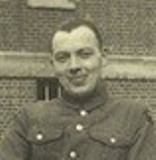Glyndyfrdwy is a village in the ancient county of Merionethshire, situated on the A5 road halfway between Corwen and Llangollen in the Dee Valley. The village lies in a historical location, with the nearby 12th Century motte and bailey castle, known as Owain Glyndŵr’s Mount, and was the location where Owain Glyndŵr was proclaimed Prince of Wales. In 1974 Glyndyfrdwy became part of Clwyd, following the Local Government Act 1972, but in 1996 it was placed within the county of Denbighshire. The men of the village who fell during both World Wars are commemorated on the Glyndyfrdwy war memorial, in the form of a Celtic Cross, which is situated beside the A5 road. Many thanks to Laura Watkins for sending in the photograph of the war memorial, plus the photo of Tegwyn Davies Jones.
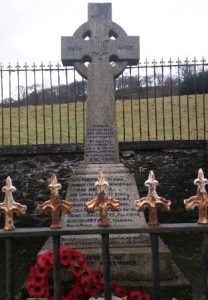
The Great War, 1914-1918
Evan Goronwy Davies, Private, 23048, Royal Welsh Fusiliers. Evan was the son of Edward and Emma Davies, of Craig Fryn, Garth Trevor. He worked as a cowman prior to the war. Evan enlisted at Birkenhead into the Royal Welsh Fusiliers, and was posted to the 9th Battalion, Royal Welsh Fusiliers. The battalion had formed at Wrexham in September 1914, before moving to Tidworth to join 58 Brigade, 19th (Western) Division. On 19 July 1915 Evan landed in France with the battalion, and the entire 19th Division then moved to the Nursery Sector at Calonne for trench initiation alongside the Dehra Dun Brigade. The infantry battalions of the division then began carrying out the usual routines of rotating in the trenches: four days in the front line; four in support; and four in reserve, interspersed with training regimes and carrying out working parties and trench raids. Just south, the British launched a great offensive around the town of Loos on 25 September 1915, and the 19th Division was ordered to attack from its positions at the same time, to attempt to draw enemy attention away from the main battle area. The attacking battalions of the 19th Division were in place by 04.00, and then at 05.50 the men climbed out of their trenches to launch their assault, behind a gas and smoke screen. The assault was a disaster, and heavy casualties were suffered by the 19th Division for no gain. Evan had been killed in action during the ill-fated attack that day. The 19-year-old has no known grave and is commemorated on the Loos Memorial, France.
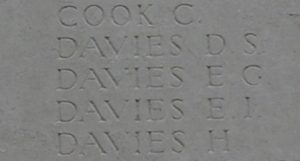
William Thomas Davies, Private, 2402, Welsh Guards. William was the illegitimate son of Catherine Davies, of Coed Ial Cottage, Corwen. He was raised by his grandparents, and had worked as a cow boy at Ty Cerrig Farm, Glyndyfrdwy prior to the war. William enlisted into the Royal Welsh Fusiliers, but was transferred to the 1st Battalion, Welsh Guards early in 1916. The Division had seen its first major action during the Battle of Loos, which began on 25 September 1915, and had suffered heavy casualties at Hill 70, before also taking part in the Action of the Hohenzollern Redoubt. The Division had a brief rest in the Calais area, before moving to the Ypres Salient, and held the line at Potijze for several months. At the end of July 1916, the Division withdrew from Ypres and moved to the Somme, before holding the line north of the Ancre for a short period. By 25 August the Guards Division had moved slightly south, and had marched passed Corbie, to Mericourt-L’Abbe. By 9 September the Guards had passed Ginchy, and moved into positions at Guillemont, prior to taking part in the Battle of Flers-Courcelette, the first-time tanks were ever used in action. The Guards Division saw heavy fighting at Flers, and then during the ensuing Battle of Morval, capturing Lesboeufs Village. After the Somme offensive had died down, the Guards remained on the Somme for the winter. On 26 December the Welsh Guards moved into the front line between Bouleaux Wood and Haie Wood, to begin a routine tour in the trenches. William was killed when the battalion came under heavy artillery fire on the following day, 27 December 1916. The 20-year-old is buried in Bronfay Farm Military Cemetery, Bray Sur Somme, France.
David Jones Edwards, Private, 301433, Tank Corps. David was born at Llwyngwril in 1897, the son of Police Sergeant Thomas William Edwards and Jane Ann Edwards (nee Sutton). The family had lived at Aberdovey and Corwen, but when Thomas retired from the Police, the family moved to 5, Glyndwr, Glyndyfrdwy. David was educated at Corwen Council School and Bala County School, then worked as a Clerk at the National and Provincial Bank at Newcastle Emlyn prior to the war. He enlisted at Carmarthen into the 2/5th Battalion, East Kent Regiment (The Buffs). David was then transferred to the 3/4th Battalion, Queen’s (Royal West Surrey’s), before being transferred to the Tank Corps, and was posted to the 13th Battalion, Tank Corps. The Tank Corps had suffered heavy losses during the Battle of Cambrai in November and December 1917. David probably joined the 13th Battalion among a draft of reinforcements after the battle. During the Spring of 1918 the 13th Battalion, Tank Corps was at Boescheppe, in Flanders, attached to the 4th Tank Brigade, which had its HQ at Godewaersvelde. On April 9 the Germans launched the second phase of their great attack against a line running from Festubert and Fleurbaix against the British front, and broke through the thinly stretched defenders. David’s battalion, now converted to a Lewis-Gun unit, had orders to hold a line west of Merville. On 25 April 1918 the Germans hit the positions held by the 13th Battalion, causing terrible casualties among the defenders. David was killed in action during the fighting that day. The 20-year-old has no known grave and is commemorated on the Tyne Cot Memorial, Belgium.
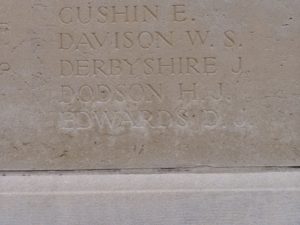
Thomas Lloyd Hughes, Private, 45117, Royal Welsh Fusiliers. Thomas was the son of Thomas and Catherine Hughes, of Minafon, Glyndyfrdwy. He worked as a Clerk prior to enlisting into the Royal Welsh Fusiliers at Abertillery on 21 February 1916, and was placed on the Army Reserve. Thomas was mobilised on 26 July 1916 and posted to Wrexham, before joining the 3rd Battalion, Royal Welsh Fusiliers at Litherland Camp, Liverpool. He embarked for France on 15 November, and was posted to the 10th Battalion, Royal Welsh Fusiliers. The battalion was attached to 76 Brigade, 3rd Division, and had suffered severe casualties on the Somme, at Delville Wood and in its attack on Serre. Thomas was wounded at Arras the following year, and on 2 May 1917 was admitted to hospital, before returning to England aboard the Hospital Ship St. Denis. Upon recovering, he embarked for Egypt on 29 November 1917, to join the 24th Battalion, Royal Welsh Fusiliers. The battalion had been formed from the Denbighshire Yeomanry in Egypt on 1 March 1917, joining 231 Brigade, 74th (Yeomanry) Division, and saw its first major action during the Second Battle of Gaza on 17 April. The battle was a failure, and the EEF was re-organised under a new commander, Sir Edmund Allenby, before launching the Third Battle of Gaza on the night of 31 October 1917. This assault was launched along a winder front, running from Gaza to Beersheba, and this time the EEF prevailed, opening the door to Jerusalem. The Division then took part in the drive north into Syria, but as a result of the heavy losses suffered in France, following the launching of the three German Spring offensives from 21 March 1918, was sent to France, landing in Marseilles on 7 May 1918. The Division underwent a system of training, to prepare it for the vastly different conditions on the Western Front, before taking over a section of the front in the St. Floris Sector. On 25 July the 24th RWF moved into reserve positions here for the first time, and began work in support of 92 Brigade, which was holding the line. On 28 June 1918 92 Brigade carried out an assault against the German positions opposite, and the 24th RWF were ordered forward to act as a carrying party. Thomas was one of two men killed whilst carrying material to help consolidate positions which had been captured by 92 Brigade. The 22-year-old has no known grave and is commemorated on the Ploegsteert Memorial, Belgium.
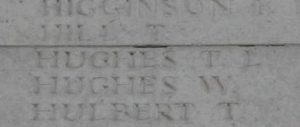
Thomas Charles Jacks, Private, 345543, Royal Welsh Fusiliers. Thomas was the son of Charles and Margaret Jacks, of Hill Side, Vron Bache, Llangollen. He worked at Llandudno Gas Works prior to the war. Thomas enlisted into the 17th Battalion, Royal Welsh Fusiliers at Llandudno on 18 August 1915. The battalion was raised at Llandudno, joining the 43rd (Welsh) Division and trained in North Wales before moving to Winchester in the summer of 1915, where the battalion joined the re-numbered 115 Brigade, 38th (Welsh) Division. The Division moved to France on 2 December 1915 and moved to the Nursery Sector near Fleurbaix for trench initiation alongside the Guards Division. Thomas suffered several spells of rheumatism during the winter, which is unsurprising due to the terrible cold, wet conditions. The Division then held a sector of the line near Cuinchy before marching south to the Somme sector in June 1916 to take part in the assault on Mametz Wood. The first attack on the wood was launched on a two-battalion front on 7 July, but failed, and the Divisional Commander, Sir Ivor Philipps, was replaced before the Division attacked again on a two Brigade front on 10 July 1916. Thomas was shot in the head during the terrible fighting in the wood, and was evacuated back to the Casualty Clearing Station at Heilly, before being taken to hospital in Rouen, and was stabilised before returning to England aboard the Hospital Ship St. Andrew. After recovering from his wound, Thomas embarked for Egypt on 16 February 1917, to join the 24th Battalion, Royal Welsh Fusiliers. The battalion had been formed from the Denbighshire Yeomanry in Egypt on 1 March 1917, joining 231 Brigade, 74th (Yeomanry) Division, and saw its first major action during the Second Battle of Gaza on 17 April. The battle was a failure, and the EEF was re-organised under a new commander, Sir Edmund Allenby, before launching the Third Battle of Gaza on the night of 31 October 1917. The 74th Division took part in an assault to capture all of the ground north of the Wadi Saba up to the Beersheba Road that night. Thomas was killed in action during the assault that day. The 34-year-old has no known grave and is commemorated on the Jerusalem Memorial, Israel.
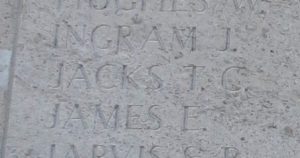
Edward Jones, Sapper, 47893, Royal Engineers. Edward was born at Bootle in 1890, the son of John and Christina Jones. His parents later ran the Sun Inn, at Glyndyfrdwy. Edward had served an engineering apprenticeship at the Rollo and Sons ship repair yard in Liverpool prior to gaining a position with Harland and Wolff. He enlisted into the Royal Engineers soon after the outbreak of war, and was posted to France on 6 December 1915, joining the 95th Field Company, Royal Engineers. By then the Company was attached to the 7th Division, which had just moved to the Somme Valley. The Division remained on the Somme for over a year, and on the opening day of the Battle of the Somme, 1 July 1916, took part in a successful assault on the village of Mametz, one of the few successes of the day. The Division then fought at the Battle of Bazentin, and the Attacks on High Wood, playing a successful part in the ‘dawn attack’, and were also the first troops into High Wood. The Division then took part in the Battle of Delville Wood, and the Battle of Guillemont, before spending the winter on the Ancre. On 23 December 1916, in pouring rain, the Company was at work on trenches at Leave Avenue, Station Alley and Tank Alley, when Edward was killed in action, together with several other men. The 26-year-old is buried in Serre Road Cemetery No.1, France. The exact location of his grave is not known, so he is commemorated on a Special Memorial within the cemetery. Edward is not commemorated on the Glyndyfrdwy war memorial.
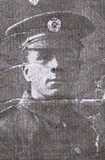
John Goronwy Jones, MM, Private, 4068, Welsh Guards. John was the son of David and Grace Jones, of Tronlwyd, Glyndyfrdwy. He worked on his parent’s farm prior to the war. John enlisted into the Welsh Guards and was posted to France during the spring of 1918, among a large number of drafts to the 1st Battalion, Welsh Guards, following heavy losses during the German Spring offensive. The 1st Welsh Guards were attached to the 3rd Guards Brigade, Guards Division, and had been stationed near Gouzeaucourt when the German Spring Offensive hit the area on 21 March 1918, and saw heavy fighting as the line withdrew under intense pressure. After two further offensives, on the Lys in April, and on the Aisne in May, the fighting calmed down, and on 8 August 1918 a combined Australian, Canadian and British success at the town of Villers Bretonneux, turned the war. On 21 August the Allies launched an attack along the Western Front, and the Guards Division took part in the advance, capturing St. Leger before advancing towards the Canal du Nord. Following the breaking of the Hindenburg Line, the Guards swept eastwards through the rest of the enemy’s trenches beyond the canal and further, reaching a line almost due south of Cambrai by 8 October, facing the Brecklin and Selle Rivers. Heavy fighting continued as the Guards pressed on, and by 2 November the Guards had reached Vertain. The town of Valenciennes had been captured the day before. On 4 November the Welsh Guards set out for Bouvignies on the road to Bavai, and saw heavy fighting over the coming days. John was wounded during the assault, and died of his wounds on 6 November 1918, just five days before the Armistice. The 24-year-old is buried in Villers-Pol Communal Cemetery Extension, France. John was awarded the Military Medal for his bravery during the great advance.
John Thomas Jones, Private, 204467, Royal Welsh Fusiliers. John was the son of Evan and Ellen Jones, of Ty Canol, Glyndyfrdwy. He worked as a farmer prior to the war. John enlisted into the 4th Battalion, Royal Welsh Fusiliers at Wrexham on 2 March 1916. He was mobilised on 12 June 1917, and was posted to Park Hall Camp, Oswestry for training. John was then posted to the Depot at Wrexham, where he was found to be unfit for the infantry, and was transferred to the 532nd Company, Labour Corps, at Wrexham. He served until after the Armistice, and had been placed back on his parents’ farm. John took ill just before being demobilised, and died of pleurisy at home on 22 March 1919. The 30-year-old is buried in St. John’s Churchyard, Glyndyfrdwy.
Richard Jones, Private, 268072, Royal Welsh Fusiliers. Richard was born on 18 October 1898, the son of Griffith and Sarah Jones, of 16, New Inn, Terrace Glyndyfrdwy. He worked as a Grocers Assistant in London prior to the war. Richard enlisted into the 18th Battalion, Royal Welsh Fusiliers in London on 15 June 1916, and was posted to Litherland Camp, Liverpool to join the 3rd Battalion, Royal Welsh Fusiliers. After completing his training, he embarked for France on 7 October 1916, joining the 5th Infantry Base Depot at Rouen. On 14 October he was posted to the 17th Battalion, Royal Welsh Fusiliers, which was at Ypres, attached to 115 Brigade, 38th (Welsh) Division, but two months later was found to be under-age and was sent back to Rouen, before returning to Litherland Camp. On 10 January 1918 he was posted back out to France, joining the 17th Battalion, Royal Welsh Fusiliers once more. The Division was, at the time, in the Armentieres Sector, but following the launching of the German offensive on the Somme on 21 March 1918, the Division was moved back to the Somme, and took up positions north of Albert, around Aveluy Wood, relieving the battered 2nd and 47th Divisions in the line facing Bouzincourt Ridge. The Germans held the high ground of the ridge, so the Division planned to assault and capture the ridge. On 25 April 1918 the 17th RWF moved into the front line, to begin a routine tour. At 12.30 on 1 May 1918, two Companies of the 17th RWF took part in an assault on Bouzincourt Ridge, following a rolling artillery barrage. The attackers failed to reach the German lines, due to heavy machine-gun fire, before being forced to withdraw following severe losses. Richard was killed in action during the attack that day. The 19-year-old is buried in Bouzincourt Ridge Cemetery, Albert, France.
George William Phillips, Private, 126529, Royal Garrison Artillery. George was the son of George and Mary Phillips, of Birmingham. He married Kate Sarah Lloyd in 1912. George enlisted into the Royal Garrison Artillery at Birmingham, and was posted to France, joining the 27th Siege Battery, RGA. Kate moved with their only child, William, to 1, New Inn Terrace, Glyndyfrdwy at some time afterwards. During the summer of 1916 the Battery was on the Somme, supporting the great Battle of the Somme from its gun positions at Martinsart. In March 1917, the Battery pulled its guns out of the Somme sector and moved north, setting up in positions at Maroeuil, to support the Arras offensive. During the first week of July the Battery moved north again, into the Ypres Salient, and began shelling German targets, as part of the softening-up process for the forthcoming Third Battle of Ypres. On the opening day, 31 July 1917, the battery concentrated its fire on a line running from the Roulers Railway to Zonnebeke, as well as responding to SOS calls, firing salvoes where necessary. The Battery remained in Ypres until after Christmas, when it moved out of the salient, to positions at Morbecque, and then to Ham en Artois. On 25 February 1918, the Battery was engaged in counter-battery work, when a salvo of German shells crashed into a dugout manned by George and five other men, killing them all instantly. George was 27-years-old when he was killed that day, and is buried in Cambrin Military Cemetery, France. George is not commemorated on the Glyndyfrdwy war memorial. His only son, William John Phillips, became a well-known actor, starring in the Onedin Line and Z-Cars, among many other roles. He was awarded the Military Cross during World War Two.
Phillip Pugh, Private, 290877, Royal Welsh Fusiliers. Philip was the son of William and Elizabeth Pugh, of Lilac Cottage, Llyndys Hill, Oswestry. He worked as a Chauffeur at Glyndyfrdwy prior to the war. Phillip enlisted at Corwen into the 7th Battalion, Royal Welsh Fusiliers on 30 November 1914. The battalion was a Territorial unit, which mobilised for war at Newtown in August 1914, as part of North Wales Brigade, Welsh Division and moved to Conway until the end of the month, before moving to Northampton. In December the Division moved to Cambridge and then in May 1915 to Bedford, where the Division was numbered and the formation became 158 Brigade, 53rd (Welsh) Division. On 19 July 1915 the entire Division sailed from Devonport for Imbros and on 9 August 1915 landed at Suvla Bay. The infantry moved off the beaches into the bush, but due to a lack of maps and no knowledge of the terrain, many of the units became disorientated, and the situation became chaotic. The Division was eventually evacuated from Gallipoli in December 1915, moving to Egypt to join the EEF, and helped guard the Suez Canal before taking part in operations to drive the Turks out of the Sinai. The EEF then turned its attention onto driving the Turks out of Palestine, and on 26 March 1917 launched its first offensive against the coastal city of Gaza, which guarded the road to Jerusalem. Initial gains during the day were lost when the assaulting divisions lost touch with each other and communication broke down when a thick fog cloaked the battlefield. Phillip had been killed in action during the fighting that day. The 23-year-old is buried in Gaza War Cemetery.
David Roberts, Private, 35512, Machine Gun Corps. David was the son of William and Margaret Roberts, of Ty-Capel, Glyndyfrdwy. He had worked as a slate quarrier prior to moving to Bootle to work in the docks. David returned to Corwen to enlist into the Royal Welsh Fusiliers on 28 February 1916, but was then transferred to the Machine Gun Corps. David embarked for France at Folkestone on 17 July 1916, and after disembarking at Boulogne was posted to the MGC Depot at Camiers. On 22 July he was posted to the 22nd Company, Machine Gun Corps, which was attached to 22nd Brigade, 7th Division. David joined the Company at Belloy, on the Somme, where it was resting following heavy fighting around High Wood. On 12 August the 22nd MGC marched from Belloy to Dernancourt, where a training scheme was carried out prior to marching to Montauban via Pommiers Redoubt on 26 August. On the following morning the Company relieved the 61st MGC in the line, and started firing machine-gun barrages on Ginchy. The same work continued on the following day, 28 August 1916, in support of an assault on Ginchy by the 1st RWF. David was killed in action during the day. The 32-year-old has no known grave, and is commemorated on the Thiepval Memorial, France.
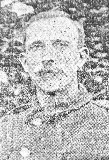
Edward Henry Rowlands, Acting Bombardier, 69886, Royal Garrison Artillery. Edward was the son of Owen Rowlands and Ellen Rowlands (nee Thomas), of 4, New Inn Terrace, Glyndyfrdwy. He worked as a slate quarryman, and had moved to Raw Cottage, Kentmere, Kendal prior to the war. Edward enlisted into the Royal Garrison Artillery at Kendal on 11 December 1915, and was placed on the Army Reserve. He was mobilised on 7 March 1916, and posted to Fort Brockhurst, Kent for training. Edward was posted to France in the spring of 1917, and joined the 13th Siege Battery, RGA. Edward served with the battery over the coming months, but as winter grew colder, his health began to fail. He was sent to the 55th Casualty Clearing Station, France, where he died of bronchitis on 25 December 1917. The 29-year-old is buried in Tincourt New British Cemetery, France.
World War Two, 1939-1945
Tegwyn Davies Jones, Corporal, 528052, Royal Air Force. Tegwyn was born in St. Asaph in 1913, the son of Edward Peter Jones and Mary Elizabeth Jones (nee Davies). His father was a ship’s engineer, from Rhyl, and his mother was from Glyndyfrdwy. His mother died when he was eight, so Tegwyn was raised by his grandparents at Glyndyfrdwy. After leaving school he worked at the Moel Fferna Slate Quarry, and prior to the war enlisted into the Royal Air Force, being posted to Hucknall, Nottingham. On 12 April 1939, Tegwyn married Margaret Blodwen Edwards, a Nurse, from Corwen. He was posted out to France with 98 Squadron, RAF in April 1940, but by now the BEF was in full retreat, being pushed back towards the French coast. The thousands of troops who had made it to Dunkirk had already been evacuated by 6 June, whilst more had been evacuated from Boulogne, Calais and Le Havre by 25 May. Tegwyn’s squadron had been forced to withdraw to the port of St. Nazaire, and on 17 June 1940, boarded the requisitioned liner, RMS Lancastria, which had just steamed into the Loire Estuary, before anchoring in the Charpentier Sounds. By the afternoon Lancastria had taken aboard a huge number of evacuees, far greater than she was built to carry, with estimates running from 4,000 to 9,000 people. The Germans had already begun attacking shipping in the area, and at 15.50 Lancastria was attacked by Junkers-88 bombers, sinking in less than 20 minutes. An estimated 6,500 people drowned in the sinking of Lancastria that day. Tegwyn was 27-years-old when he died as a result of the sinking of the Lancastria that day. Tegwyn has no known grave and is commemorated on the Runnymede Memorial, Surrey.
